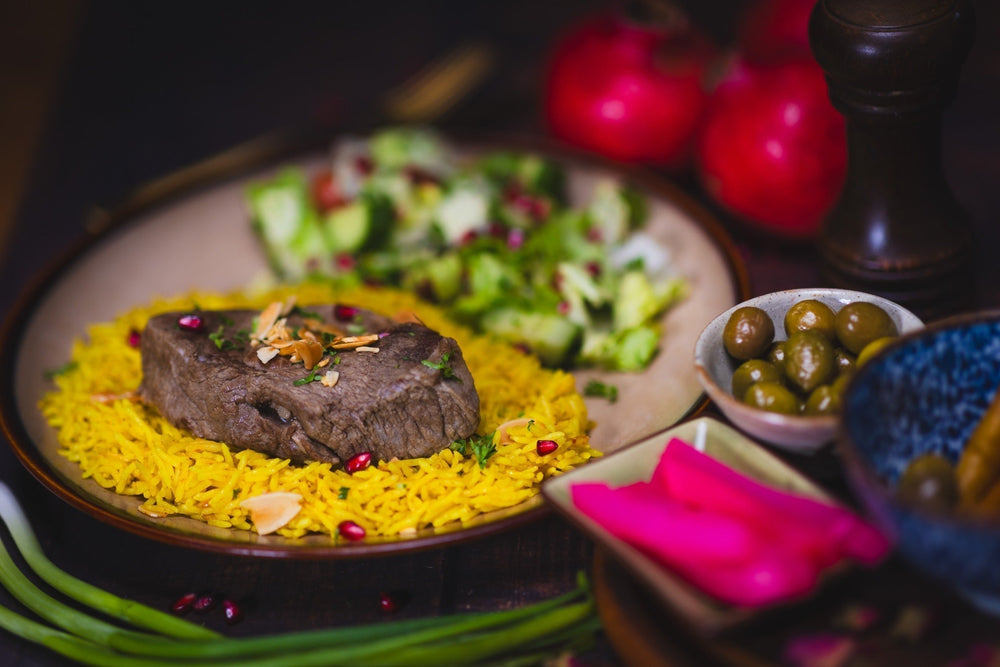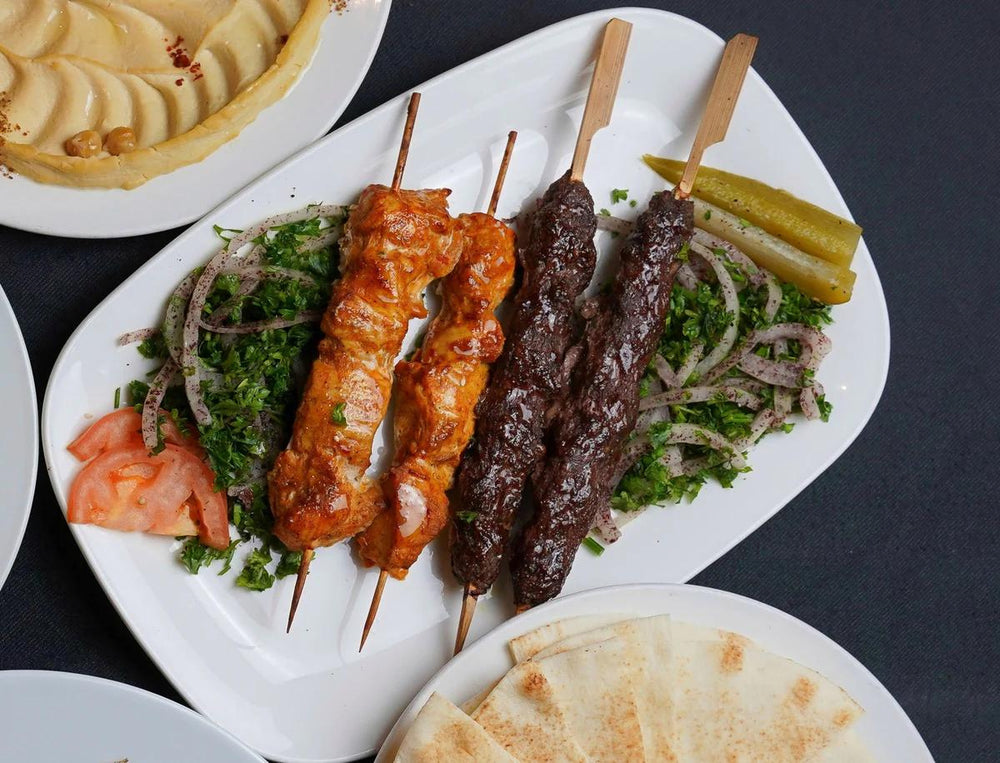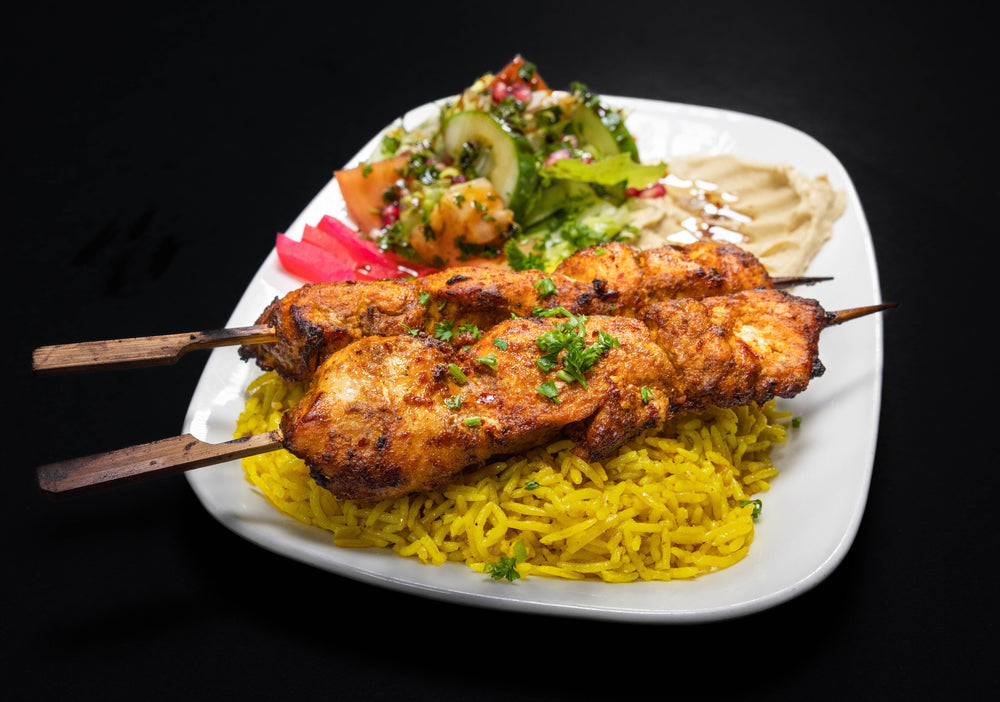A Deep Dive Into Syrian Cuisine: Recognizing Its Cultural Relevance and Halal Facets
Syrian cuisine symbolizes an abundant tapestry of social impacts and historical narratives. Each meal informs a story of area and practice, stressing the relevance of shared meals. The adherence to halal practices not just shows religions but additionally shapes the identification of Syrian food preparation. As worldwide events test these culinary customs, the resilience of this food stays a centerpiece of cultural conservation. What exists behind the flavors that define this withstanding heritage?
The Historical Roots of Syrian Food
Although Syrian cuisine has evolved over centuries, its historic origins are deeply intertwined with the area's varied cultural impacts. Located at the crossroads of various worlds, Syria has actually absorbed cooking methods from the Phoenicians, Greeks, Romans, and Ottomans, amongst others. This rich tapestry of background has actually added to a cuisine characterized by a mix of tastes, flavors, and cooking strategies. The fertile lands of the area have additionally played a necessary function, providing a wealth of grains, fruits, and vegetables that create the foundation of several dishes. The intro of new active ingredients with profession and occupation better enriched the cooking landscape, enabling the growth of distinct local specializeds. Additionally, the impact of neighboring countries has actually resulted in a dynamic exchange of culinary concepts, solidifying Syria's setting as a significant player in the more comprehensive context of Middle Eastern gastronomy.

Traditional Syrian Recipes and Their Cultural Relevance
Traditional Syrian recipes are not only culinary staples but likewise lug deep cultural significance, mirroring the nation's abundant heritage. Legendary dishes, commonly prepared during cheery events, work as a method of joining communities and family members. These dishes personify the flavors of Syria while strengthening social bonds through shared events and practices.
Iconic Syrian Staples
When checking out the rich tapestry of Syrian food, one discovers a range of renowned dishes that not just tantalize the taste buds yet additionally embody the nation's social heritage. Among these staples, Kabsa attracts attention as a fragrant rice meal, often skilled with spices like saffron and cardamom, symbolizing hospitality. Fattoush, a lively salad made with combined greens and crunchy bread, shows the importance of fresh components in Syrian cooking. Muhammara, a spicy dip made from peppers and walnuts, showcases the abundant flavors particular of the area. Furthermore, Kibbeh, a recipe made from bulgur and minced meat, is typically considered as a national prize, standing for communal celebrations. Each dish narrates, linking individuals to their origins and practices.
Festive Meal Traditions
Syrian festive dish customs are rich with symbolism and value, as family members gather to celebrate important celebrations with the sharing of beloved recipes. Dishes commonly showcase an array of traditional foods, with dishes like tabbouleh, kibbeh, and mansaf taking spotlight. Each recipe brings social background; as an example, kibbeh, made from bulgur and minced meat, represents hospitality and wealth. Throughout Ramadan and Eid, households prepare special sugary foods such as maamoul, symbolizing pleasure and unity. These celebrations promote area bonds, as sharing a meal indicates love and togetherness. The prep work and pleasure of these dishes mirror Syria's varied culinary heritage, linking family members customs and local influences, thereby improving the joyful experience and maintaining cultural identification.
The Role of Household and Neighborhood in Syrian Food Society
Food offers as an essential string that weaves together family members and area in Syrian culture. Dishes are usually communal experiences, where families gather around a table to share standard dishes that mirror their heritage. The preparation of food is a public activity, with generations functioning side by side, passing down recipes and cooking strategies. This practice reinforces familial bonds and promotes a sense of belonging within the community.Special celebrations and religious parties even more highlight the relevance of food in Syrian culture. Throughout these events, family members prepare elaborate meals that serve not only to nourish but also to reveal love and friendliness. The act of sharing food symbolizes unity and support among friends and neighbors, reinforcing social connections. Through these shared cooking experiences, Syrians grow a solid identification rooted in their rich cultural history, showing exactly how food goes beyond plain nutrition to become an essential component of their social textile.
Halal Practices in Syrian Cooking
In the context of communal meals and household celebrations, halal practices play a considerable duty in Syrian food preparation. These practices stem from Islamic dietary legislations, making certain that food is prepared and eaten in a fashion that lines up with faiths. For several Syrian families, adherence to halal principles influences different elements of dish prep work, from sourcing ingredients to cooking methods.Animals used for meat should be butchered according to specific guidelines, highlighting gentle treatment and invoking the name of Allah. Additionally, cross-contamination with non-halal products is carefully prevented in both home cooking areas and commercial establishments.This dedication to halal not only reflects spiritual dedication yet additionally cultivates a feeling of neighborhood, as households typically integrated to share dishes that recognize these customs - Brunch Kitsilano Vancouver BC. As a result, halal techniques are deeply woven into the textile of Syrian culinary society, shaping both everyday life and cheery occasions
Ingredients That Specify Syrian Tastes

The essence of Syrian food is formed by an unified mix of crucial seasonings and natural herbs that boost its distinctive flavors. Traditional cooking techniques further boost these active ingredients, showcasing the abundant culinary heritage of the region. An overview of important ingredients discloses the foundational role they play in developing genuine Syrian meals.
Key Seasonings and Herbs
A vibrant tapestry of tastes defines Syrian food, with crucial flavors and herbs playing a vital role in specifying its significance. Popular among these are cumin, sumac, and coriander, which lend deepness and heat to different dishes. Cumin, with its nutty aroma, usually improves stews and smoked meats, while coriander includes a citrusy note to dips and salads. Sumac, recognized for its tasty taste, brightens recipes and is often sprinkled over fattoush or kebabs. In addition, cinnamon and allspice give a subtle sweet taste, frequently discovered in both tasty and sweet prep work. Fresh herbs like dill, parsley, and mint are also essential, supplying a ruptured of freshness and stabilizing the rich, complicated tastes that make Syrian cuisine one-of-a-kind.
Conventional Cooking Methods
Food preparation strategies in Syrian food mirror an ingrained practice that enhances the tastes of its active ingredients. Methods such as slow-cooking and braising are generally employed, enabling natural herbs and spices to fuse magnificently with meats and vegetables. Barbecuing, specifically over charcoal, imparts a great smoky richness to meals like kebabs, while steaming is often utilized for rice, maintaining its texture and preference. Additionally, sautéing is preferred for preparing fragrant bases, often starting with onions and garlic to develop deepness. Fermentation plays a duty in creating distinct flavors, obvious in recipes like pickled vegetables. These techniques not only highlight the high quality of components however also symbolize the communal spirit of food preparation, bringing Visit Website family members together around shared meals soaked in tradition.
Necessary Active Ingredients Overview
While exploring Syrian cuisine, one swiftly finds that necessary active ingredients play a crucial duty in defining its unique flavors. Olive oil, a staple, provides richness and deepness, often working as a base for lots of dishes. Fresh natural herbs, such as cilantro, parsley, and mint, add lively scents and preferences, improving the overall experience (Brunch Kitsilano Vancouver BC). Seasonings like cumin, coriander, and cinnamon are regularly used, adding warmth and complexity to dishes. Additionally, Syrian cuisine heavily integrates grains, specifically bulgur and rice, which function as fundamental components in numerous dishes. Pulses, especially lentils and chickpeas, supply both nourishment and texture. With each other, these ingredients create the unified balance that identifies Syrian recipes, showing the country's abundant culinary heritage and social importance
The Impact of War on Syrian Cooking Customs
Although the war in Syria has actually functioned destruction across the nation, its impact on culinary practices exposes an intricate interplay of resilience and adjustment. As areas faced variation, conventional dishes were modified as a result of the scarcity of resources and active ingredients. Households typically relied on in Continue your area available produce, including new tastes and strategies right into their meals, which caused the emergence of one-of-a-kind interpretations of traditional dishes.Moreover, the battle fostered a spirit of uniformity amongst displaced cooks and home cooks, who shared their cooking expertise through social networks and area kitchens. This sharing of recipes not just managed social heritage yet additionally developed a sense of belonging amongst those affected by the dispute. In spite of the challenges, the interest for food remains a unifying force, enabling people to preserve their identification and connect with their origins, also in expatriation. Consequently, Syrian cuisine remains to advance amid hardship, reflecting both an abundant history and modern durability.
Frequently Asked Concerns
What Are Typical Food Preparation Methods Utilized in Syrian Cuisine?
Usual food preparation strategies in Syrian food consist of barbecuing, cooking, sautéing, and cooking. These techniques improve flavors and textures, enabling the production of varied meals that reflect the area's rich culinary heritage and traditions.
Just How Has Globalization Influenced Syrian Food?

Exist Vegetarian Options in Standard Syrian Recipes?
Vegetarian options prevail in conventional Syrian meals, featuring active ingredients like lentils, veggies, and chickpeas. Popular recipes such as Mujadara and Falafel emphasize this diversity, fitting different dietary choices while protecting the abundant tastes of the food.
What Beverages Pair Well With Syrian Dishes?
Beverages that match well with Syrian dishes consist of mint tea, pomegranate juice, and ayran - Brunch Kitsilano Vancouver BC. These beverages match the tastes of typical meals, enhancing the eating experience while supplying invigorating contrasts to the abundant, full-flavored tastes
Exactly How Do Syrians Commemorate Food Throughout Holidays or Festivals?
Syrians commemorate food during holidays and festivals with fancy banquets, typically featuring typical dishes. Household gatherings highlight sharing dishes, symbolizing unity and cultural heritage, while special treats and desserts highlight the joyful spirit and communal happiness. Conventional Syrian dishes are not only cooking staples but likewise lug deep cultural relevance, reflecting the nation's abundant heritage. When exploring the rich tapestry of Syrian food, one discovers a range of legendary dishes that not just entice the taste but likewise personify the country's cultural heritage. Syrian joyful dish traditions are rich with symbolism and value, as families gather to celebrate essential events via the sharing of precious meals. Food preparation techniques in Syrian cuisine show an ingrained practice that enhances the flavors of its website link ingredients. Vegetarian choices are common in typical Syrian recipes, featuring ingredients like lentils, chickpeas, and veggies.